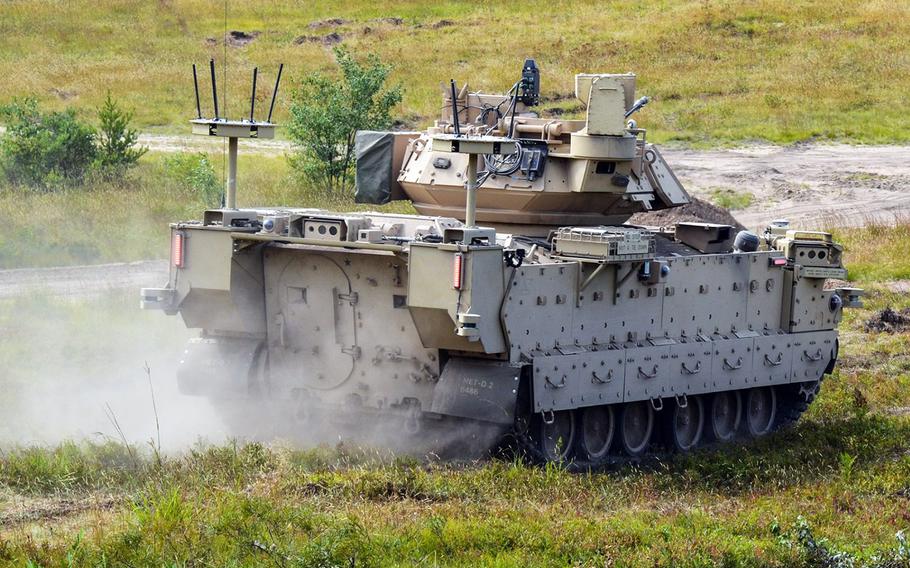
A Modified Bradley Fighting Vehicle, being tested by soldiers at Fort Carson, Colo. (Kimberly Derryberry/DOD)
WASHINGTON — The Army and Marine Corps are working on robots for the next generation of mechanized warfare and troops are already testing their effectiveness in combat and reconnaissance, Army officials said Thursday.
Troops with the 4th Squadron, 10th Cavalry Regiment, 3rd Brigade Combat Team, 4th Infantry Division have been testing unmanned Bradley Fighting Vehicles and M113 armored personnel carriers in platoon training events, including a live-fire exercise the past few weeks at Fort Carson, Colo.
Army leaders said unmanned combat vehicles require soldiers to operate them at a relatively short distance away, roughly 1,500 to 2,000 meters depending on the terrain. But the ability for a cavalry unit to send Bradleys to scout an area or engage an enemy allows more soldiers to stay in the rear, potentially saving lives, they said.
“This isn’t about robots, this isn’t about technology,” Brig. Gen. Ross Coffman said. “It’s about soldiers, reducing the risk to our men and women. These robots are absolutely going to do that. We aren’t there yet, but this technology is emerging. This technology can add a lot of benefits to the battlefield. I can guarantee we’ll have robots sensing, shooting and detecting, conducting support by fire and route reconnaissance [in the future].”
Sergeant Major of the Army Michael Grinston called unmanned mechanized combat the “way of the future” in a call with reporters Thursday. But robots are still in their infancy. There is a long road ahead on figuring out how to integrate these robots into mechanized infantry and cavalry units, figuring out how many soldiers should operate them, and overcoming technical obstacles.
A traditional manned Bradley requires at least three soldiers to operate — a commander, a driver and a gunner. This is also the case with almost all ground combat vehicles. The Army officials said they are developing vehicles that are essentially ground drones that can both minimize the risk of troops getting killed in combat, and in the long term requires fewer soldiers to operate.
Coffman said unmanned vehicles require two remote operators — a driver, and a gunner. However, he said that could change, there’s no standard operating procedure yet. The military is still studying what the cognitive burden is on troops operating these vehicles, but as autonomy and technology progress, fewer soldiers might be needed to operate one or even multiple vehicles down the road. However, the goal isn’t to have vehicles able to operate totally without troops in some control.
“A full autonomous vehicle, we don’t want a fully autonomous vehicle. We don’t want a vehicle making decisions. The human is in charge. To reduce the cognitive strain on humans, we’re looking for the machine to take some [tasks] off of the human," said Coffman, who is tasked with developing a fleet of modern unmanned vehicles for the Army.
Army leaders said they hope unmanned vehicles can be used to engage an enemy first on the battlefield, making surprise attacks against U.S. service members less likely.
Coffman said the Army is building this technology alongside the Marine Corps.
Now, the unmanned ground vehicles generally require a direct line of sight in open terrain to control, according to Coffman. This means hills, trees and possibly bad weather could hinder the ability for soldiers to control the vehicles. Jeffrey Langhout, director of the Ground Vehicle Systems Center, the laboratory for advancing military vehicles, said the vehicles cannot sense whether a puddle is shallow or eight feet deep.
Infantry and cavalry leaders on the ground are still exploring ways to deploy unmanned vehicles. Since troops have to be relatively close to the vehicles, Coffman said they could set up in an overwatch position on the ground to maneuver vehicles short distances for reconnaissance to assure the area is clear to send in soldiers on foot or manned vehicles.
“This allows us to remain in a covered and concealed position to make decisions,” Coffman said.
Another option could be operating unmanned vehicles from inside a traditional manned vehicle and have the robots bound alongside regular vehicles. Coffman also said it is possible to control these vehicles from a helicopter.
He said soldiers only need about 30 minutes to get a handle on the remote control technology which operates the unmanned vehicles and fire the weapons.
“They grew up in this environment of gaming, I thought it was going to take days,” Coffman said.
With unmanned ground vehicles being in the very early stages of development, there’s no timetable to issue them to units and they could be very far off from being used in combat. However, Coffman said there could be news in 2023 on when mechanized units could get unmanned vehicles. There’s another exercise planned at Fort Hood in spring 2022, where unmanned vehicles will be used in company-level training.
Beynon.Steven@Stripes.com Twitter: @StevenBeynon